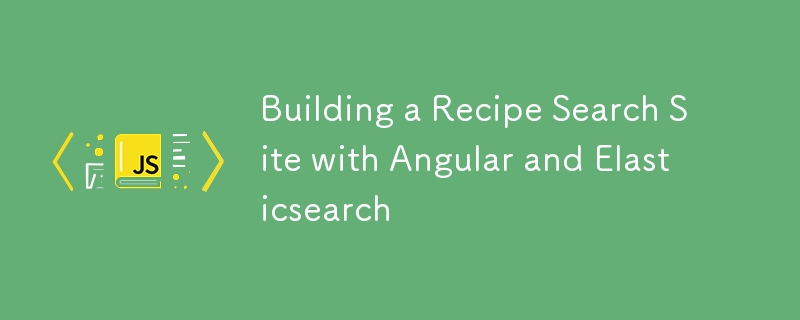This article demonstrates building a recipe search website using Angular and Elasticsearch. Tired of wrestling with Solr or Lucene? Elasticsearch, an open-source, Lucene-based storage engine, offers a simpler solution since 2010. It's more than just a search engine; it's a document store prioritizing search speed. For many applications, it can serve as the entire backend.

Key Advantages:
- Leverages Elasticsearch's JSON compatibility with OpenRecipes, a readily available JSON recipe dataset.
- Utilizes Elasticsearch's RESTful API for straightforward interaction with various environments (JavaScript driver used here).
- Employs AngularJS for the user interface, seamlessly integrating with the Elasticsearch backend for efficient data retrieval and display.
- Addresses deployment security concerns by highlighting the need for a proxy to protect the Elasticsearch instance (lacking inherent user/permission controls).
Building the Recipe Search Engine:
This tutorial guides you through creating a recipe search engine similar to OpenRecipeSearch.com. OpenRecipes provides a convenient JSON format, perfectly aligning with Elasticsearch's JSON structure.
- Setup: Download and run Elasticsearch. Its built-in RESTful backend simplifies interaction. The JavaScript driver is used in this example.
-
Data Ingestion: Obtain the OpenRecipes database (a large JSON file). A provided Node.js script (
load_recipes.js) efficiently loads this data into Elasticsearch. This script uses the Elasticsearch JavaScript library (npm install elasticsearch). -
Verification: Verify the data import using
curl(if available):curl -XPOST http://localhost:9200/recipes/recipe/_search -d '{"query": {"match": {"_all": "cake"}}}'
Building the Recipe Search UI (with Angular):
AngularJS is used to create the user interface. The process involves:
- User Input: The user enters a search query.
- Elasticsearch Query: The query is sent to Elasticsearch.
- Result Retrieval: Search results are retrieved.
- Result Rendering: Results are displayed to the user.
The provided HTML code showcases the Angular directives used to build the search interface. Key Angular concepts are explained, including directives (ng-app, ng-controller, etc.), template variables ({{}}), and data binding.
The JavaScript code includes:
-
Module Creation:
window.MyOpenRecipes = angular.module('myOpenRecipes', ['elasticsearch'], ...);sets up the Angular module. -
Controller (
recipeCtrl): Manages UI interaction, including search and pagination. -
Service (
recipeService): Handles communication with the Elasticsearch backend. This service uses the Elasticsearch JavaScript library and the$qservice for promise handling.
Deployment Notes:
For production deployment, secure your Elasticsearch instance. Elasticsearch lacks built-in user/permission management; a proxy (like nginx) is recommended to restrict access to only necessary endpoints (e.g., /recipes/recipe/_search).
Conclusion:
This tutorial provides a practical guide to building a functional recipe search website using Angular and Elasticsearch. The complete code is available on GitHub (link not provided in original text). The FAQs section addresses common questions regarding pagination, query optimization, error handling, security, testing, deployment, real-time search, aggregations, autocomplete, and cluster performance monitoring.
The above is the detailed content of Building a Recipe Search Site with Angular and Elasticsearch. For more information, please follow other related articles on the PHP Chinese website!

Hot AI Tools

Undress AI Tool
Undress images for free

Undresser.AI Undress
AI-powered app for creating realistic nude photos

AI Clothes Remover
Online AI tool for removing clothes from photos.

Clothoff.io
AI clothes remover

Video Face Swap
Swap faces in any video effortlessly with our completely free AI face swap tool!

Hot Article

Hot Tools

Notepad++7.3.1
Easy-to-use and free code editor

SublimeText3 Chinese version
Chinese version, very easy to use

Zend Studio 13.0.1
Powerful PHP integrated development environment

Dreamweaver CS6
Visual web development tools

SublimeText3 Mac version
God-level code editing software (SublimeText3)

Hot Topics
 Which Comment Symbols to Use in JavaScript: A Clear Explanation
Jun 12, 2025 am 10:27 AM
Which Comment Symbols to Use in JavaScript: A Clear Explanation
Jun 12, 2025 am 10:27 AM
In JavaScript, choosing a single-line comment (//) or a multi-line comment (//) depends on the purpose and project requirements of the comment: 1. Use single-line comments for quick and inline interpretation; 2. Use multi-line comments for detailed documentation; 3. Maintain the consistency of the comment style; 4. Avoid over-annotation; 5. Ensure that the comments are updated synchronously with the code. Choosing the right annotation style can help improve the readability and maintainability of your code.
 Java vs. JavaScript: Clearing Up the Confusion
Jun 20, 2025 am 12:27 AM
Java vs. JavaScript: Clearing Up the Confusion
Jun 20, 2025 am 12:27 AM
Java and JavaScript are different programming languages, each suitable for different application scenarios. Java is used for large enterprise and mobile application development, while JavaScript is mainly used for web page development.
 Javascript Comments: short explanation
Jun 19, 2025 am 12:40 AM
Javascript Comments: short explanation
Jun 19, 2025 am 12:40 AM
JavaScriptcommentsareessentialformaintaining,reading,andguidingcodeexecution.1)Single-linecommentsareusedforquickexplanations.2)Multi-linecommentsexplaincomplexlogicorprovidedetaileddocumentation.3)Inlinecommentsclarifyspecificpartsofcode.Bestpractic
 Mastering JavaScript Comments: A Comprehensive Guide
Jun 14, 2025 am 12:11 AM
Mastering JavaScript Comments: A Comprehensive Guide
Jun 14, 2025 am 12:11 AM
CommentsarecrucialinJavaScriptformaintainingclarityandfosteringcollaboration.1)Theyhelpindebugging,onboarding,andunderstandingcodeevolution.2)Usesingle-linecommentsforquickexplanationsandmulti-linecommentsfordetaileddescriptions.3)Bestpracticesinclud
 JavaScript Data Types: A Deep Dive
Jun 13, 2025 am 12:10 AM
JavaScript Data Types: A Deep Dive
Jun 13, 2025 am 12:10 AM
JavaScripthasseveralprimitivedatatypes:Number,String,Boolean,Undefined,Null,Symbol,andBigInt,andnon-primitivetypeslikeObjectandArray.Understandingtheseiscrucialforwritingefficient,bug-freecode:1)Numberusesa64-bitformat,leadingtofloating-pointissuesli
 JavaScript vs. Java: A Comprehensive Comparison for Developers
Jun 20, 2025 am 12:21 AM
JavaScript vs. Java: A Comprehensive Comparison for Developers
Jun 20, 2025 am 12:21 AM
JavaScriptispreferredforwebdevelopment,whileJavaisbetterforlarge-scalebackendsystemsandAndroidapps.1)JavaScriptexcelsincreatinginteractivewebexperienceswithitsdynamicnatureandDOMmanipulation.2)Javaoffersstrongtypingandobject-orientedfeatures,idealfor
 How to work with dates and times in js?
Jul 01, 2025 am 01:27 AM
How to work with dates and times in js?
Jul 01, 2025 am 01:27 AM
The following points should be noted when processing dates and time in JavaScript: 1. There are many ways to create Date objects. It is recommended to use ISO format strings to ensure compatibility; 2. Get and set time information can be obtained and set methods, and note that the month starts from 0; 3. Manually formatting dates requires strings, and third-party libraries can also be used; 4. It is recommended to use libraries that support time zones, such as Luxon. Mastering these key points can effectively avoid common mistakes.
 JavaScript: Exploring Data Types for Efficient Coding
Jun 20, 2025 am 12:46 AM
JavaScript: Exploring Data Types for Efficient Coding
Jun 20, 2025 am 12:46 AM
JavaScripthassevenfundamentaldatatypes:number,string,boolean,undefined,null,object,andsymbol.1)Numbersuseadouble-precisionformat,usefulforwidevaluerangesbutbecautiouswithfloating-pointarithmetic.2)Stringsareimmutable,useefficientconcatenationmethodsf






